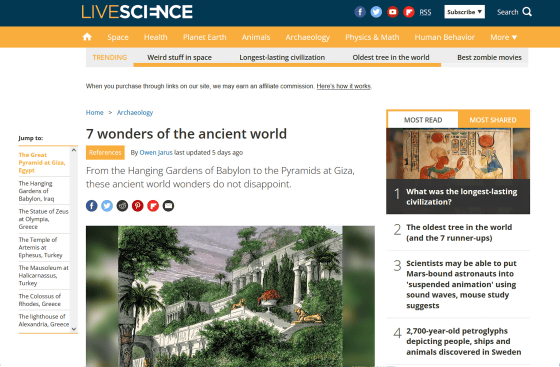What is the amazing building 'Seven Wonders of the Ancient World' made by ancient people?

The '
7 wonders of the ancient world | Live Science
https://www.livescience.com/seven-wonders-of-the-ancient-world

The seven wonders of the world were first discussed by the ancient Greek historian Herodotus , and in 225 BC Philon of Byzantium who was a traveler elected seven candidates including ' The Walls of Babylon ' etc. . According to the Seven Wonders of the World, the walls of Babylon have been removed and replaced by the Lighthouse of Alexandria.
◆ 1: Great Pyramid of Giza

The
Even at the time of writing the article, archaeologists are investigating the inside of the pyramid, and in 2023, a research team such as Nagoya University will use cosmic rays to discover a ``hidden space inside the pyramid''. Facts are revealed one after another. By reading the article below, you can experience a 3D virtual tour walking around the Great Pyramid of Giza on your browser.
3D virtual tour 'Inside the Great Pyramid' where you can freely look around the Great Pyramid of Giza - GIGAZINE

◆ 2: Hanging Gardens of Babylon

by wikimedia commons
Legend has it that in the 6th century BC, Nebuchadnezzar II , king of the Neo-Babylonian Empire , built a huge labyrinth of waterfalls and dense vegetation in his palace for his wife from the verdant kingdom of Media. . It is said that the garden was sloping like a hillside and layered like a theatre, as the queen longed for the greenery of mountainous regions.
However, the location of Babylon's Hanging Gardens has not been determined until the present day, and archaeological surveys in the ancient city of Babylon did not find any remains that could be clearly identified as hanging gardens. According to one theory, ancient writers misplaced the Hanging Gardens of Babylon, and that it was actually built in Nineveh in Mesopotamia instead of Babylon.
◆3: Statue of Zeus in Olympia

by wikimedia commons
In 435 BC, the ancient Greek city of
The surface was covered with ivory, and the head almost touched the roof while sitting. I am writing. Also, the Roman emperor Caligula planned to steal the Zeus statue around 40 AD, but Caligula was assassinated before the order was executed. It is not known when the statue of Zeus was destroyed, but it was probably destroyed around the 5th century as the ancient Greek religion was persecuted when Christianity became the state religion of the Roman Empire at the end of the 4th century. It is believed that
◆ 4: Temple of Artemis in Ephesus

by wikimedia commons
The Temple of Artemis is a total marble temple dedicated to
In 356 BC, the Temple of Artemis was set on fire, and the culprit is said to be Herostratos, a man seeking fame. However, historian Michael Immendorfer has questioned this theory, proposing that a man who was actually burned by lightning was made a scapegoat. The Temple of Artemis was later rebuilt, but was looted and destroyed during a Gothic raid in 262 AD.
◆ 5: Mausoleum of Mausolus in Halicarnassus

by wikimedia commons
Mausolus Mausoleum is a mausoleum built in
It is said that the construction of the mausoleum began during Mausolus's lifetime, with the participation of the famous sculptors Scopas, Bryaxis, Leochares and Timotheus, and continued after the death of his surviving wife, Artemisia. rice field. Pliny , a Roman literary figure, wrote that the mausoleum was about 43m high and had a pyramidal dome supported by 63 pillars at the top.
◆ 6: Colossus of Rhodes Island

by wikimedia commons
In 305-304 BC, the southeastern Aegean
First of all, a marble pedestal about 15m high was set up, and a colossus with a height of 34m was made on top of it, and it is said that the total height was close to 50m. After being destroyed by an earthquake in 226 BC, the remains remain, and according to Pliny, few people could put their arm around the colossus' thumb.
◆ 7: Great Lighthouse of Alexandria

by wikimedia commons
Around the 3rd century BC, a huge lighthouse called the Great Lighthouse of Alexandria was built on the island of Pharos at the entrance to the port of Alexandria at the mouth of the Nile. The Great Lighthouse of Alexandria is said to have reached a height of 122 to 134m. Pharos Island and the mainland were connected by a man-made passageway, and it is said that the passageway inside was wide enough for donkeys to climb.
It is said that during the day the mirrors were used to reflect the sunlight, and at night the firewood was burned and the flames were reflected by the mirrors. The Great Lighthouse of Alexandria was partially destroyed by the 796 earthquake, but was completely destroyed by an earthquake in the 14th century. However, in 1994, a French research team discovered pillars and statues that could be concluded as ruins on the seabed, and research is still underway.
Related Posts:
in Note, Posted by log1h_ik






